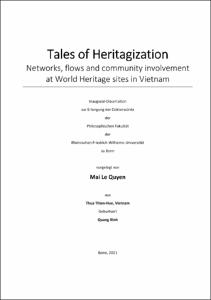Mai Le, Quyen: Tales of Heritagization : Networks, flows and community involvement at World Heritage sites in Vietnam. - Bonn, 2021. - Dissertation, Rheinische Friedrich-Wilhelms-Universität Bonn.
Online-Ausgabe in bonndoc: https://nbn-resolving.org/urn:nbn:de:hbz:5-64776
Online-Ausgabe in bonndoc: https://nbn-resolving.org/urn:nbn:de:hbz:5-64776
@phdthesis{handle:20.500.11811/9456,
urn: https://nbn-resolving.org/urn:nbn:de:hbz:5-64776,
author = {{Quyen Mai Le}},
title = {Tales of Heritagization : Networks, flows and community involvement at World Heritage sites in Vietnam},
school = {Rheinische Friedrich-Wilhelms-Universität Bonn},
year = 2021,
month = dec,
note = {The study entangles the relation between World heritage (WH) – as a selective process termed as heritagization, and community – as a heterogeneous construct. It holds three key objectives. First, it aims to deconstruct the process of heritagization, which is argued to be dominated by the powerful elites. Second, given such dominance, it explores the ways that the community mobilised to get involved in the process. And lastly, it questions whether the community is grassrooting towards the dominant sphere. From June 2017 to July 2018, an ethnographic study has been conducted at two WH sites in Vietnam, including a cultural and a natural designation.
Expanding the argument of Di Givione, the study has illuminated that heritagization is an on-going transnational process, characterised by three different phases (including isolation, idealisation, and valorisation) and two intertwined facets. It finds out that the community gets involved in the two later phases. However, the roles of the community only becomes more as the subject in the last valorisation phase. Moreover, the research identifies different forms of community involvement ranging from passive to active. Hence, only a minority of groups with a certain set of assets are seen to be able to manoeuvre for involvement. This concludes that the community is heterogonous and dynamic in both place-based and non-place-based terms. Finally, the research has pinpointed to an increasing trend of grassrooting up to the dominant sphere, in which the community utilises information communication technologies to bypass the nation state and to enhance their benefits and influence.
The research has contributed insights into the processual understanding of both heritage and community. It has identified not only the actual positions of actors at certain phases but also the involvement of the community in particular. Theoretically, it questions the usefulness of the community concept in heritage studies. On a practical note, the study suggests potential ways of empowering the community in the heritagization through the utilisation of technological innovations.},
url = {https://hdl.handle.net/20.500.11811/9456}
}
urn: https://nbn-resolving.org/urn:nbn:de:hbz:5-64776,
author = {{Quyen Mai Le}},
title = {Tales of Heritagization : Networks, flows and community involvement at World Heritage sites in Vietnam},
school = {Rheinische Friedrich-Wilhelms-Universität Bonn},
year = 2021,
month = dec,
note = {The study entangles the relation between World heritage (WH) – as a selective process termed as heritagization, and community – as a heterogeneous construct. It holds three key objectives. First, it aims to deconstruct the process of heritagization, which is argued to be dominated by the powerful elites. Second, given such dominance, it explores the ways that the community mobilised to get involved in the process. And lastly, it questions whether the community is grassrooting towards the dominant sphere. From June 2017 to July 2018, an ethnographic study has been conducted at two WH sites in Vietnam, including a cultural and a natural designation.
Expanding the argument of Di Givione, the study has illuminated that heritagization is an on-going transnational process, characterised by three different phases (including isolation, idealisation, and valorisation) and two intertwined facets. It finds out that the community gets involved in the two later phases. However, the roles of the community only becomes more as the subject in the last valorisation phase. Moreover, the research identifies different forms of community involvement ranging from passive to active. Hence, only a minority of groups with a certain set of assets are seen to be able to manoeuvre for involvement. This concludes that the community is heterogonous and dynamic in both place-based and non-place-based terms. Finally, the research has pinpointed to an increasing trend of grassrooting up to the dominant sphere, in which the community utilises information communication technologies to bypass the nation state and to enhance their benefits and influence.
The research has contributed insights into the processual understanding of both heritage and community. It has identified not only the actual positions of actors at certain phases but also the involvement of the community in particular. Theoretically, it questions the usefulness of the community concept in heritage studies. On a practical note, the study suggests potential ways of empowering the community in the heritagization through the utilisation of technological innovations.},
url = {https://hdl.handle.net/20.500.11811/9456}
}






